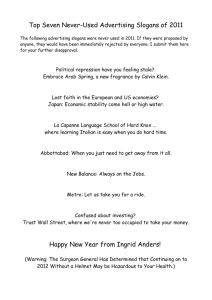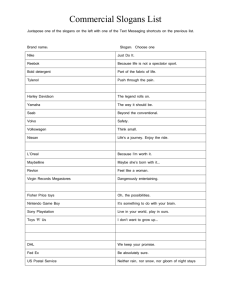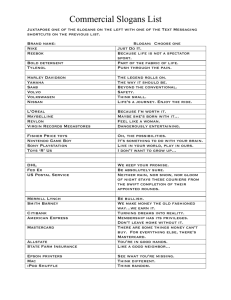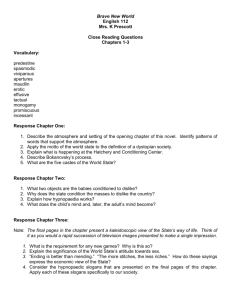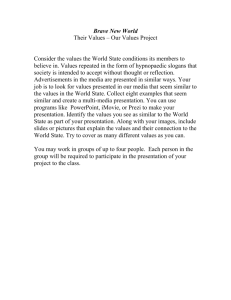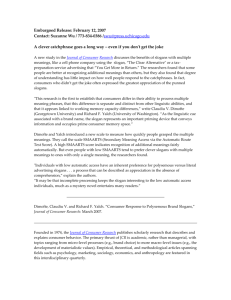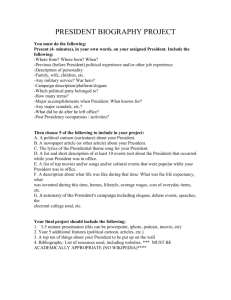Internet and DataMining Serving Personalized Marketing
advertisement
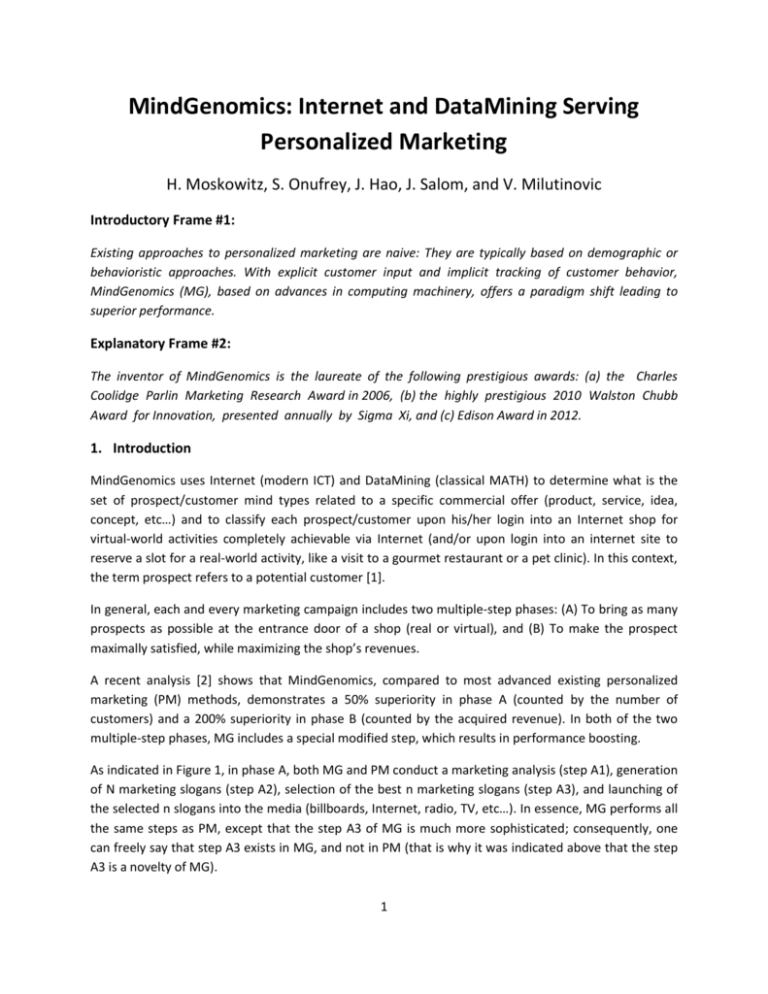
MindGenomics: Internet and DataMining Serving Personalized Marketing H. Moskowitz, S. Onufrey, J. Hao, J. Salom, and V. Milutinovic Introductory Frame #1: Existing approaches to personalized marketing are naive: They are typically based on demographic or behavioristic approaches. With explicit customer input and implicit tracking of customer behavior, MindGenomics (MG), based on advances in computing machinery, offers a paradigm shift leading to superior performance. Explanatory Frame #2: The inventor of MindGenomics is the laureate of the following prestigious awards: (a) the Charles Coolidge Parlin Marketing Research Award in 2006, (b) the highly prestigious 2010 Walston Chubb Award for Innovation, presented annually by Sigma Xi, and (c) Edison Award in 2012. 1. Introduction MindGenomics uses Internet (modern ICT) and DataMining (classical MATH) to determine what is the set of prospect/customer mind types related to a specific commercial offer (product, service, idea, concept, etc…) and to classify each prospect/customer upon his/her login into an Internet shop for virtual-world activities completely achievable via Internet (and/or upon login into an internet site to reserve a slot for a real-world activity, like a visit to a gourmet restaurant or a pet clinic). In this context, the term prospect refers to a potential customer [1]. In general, each and every marketing campaign includes two multiple-step phases: (A) To bring as many prospects as possible at the entrance door of a shop (real or virtual), and (B) To make the prospect maximally satisfied, while maximizing the shop’s revenues. A recent analysis [2] shows that MindGenomics, compared to most advanced existing personalized marketing (PM) methods, demonstrates a 50% superiority in phase A (counted by the number of customers) and a 200% superiority in phase B (counted by the acquired revenue). In both of the two multiple-step phases, MG includes a special modified step, which results in performance boosting. As indicated in Figure 1, in phase A, both MG and PM conduct a marketing analysis (step A1), generation of N marketing slogans (step A2), selection of the best n marketing slogans (step A3), and launching of the selected n slogans into the media (billboards, Internet, radio, TV, etc…). In essence, MG performs all the same steps as PM, except that the step A3 of MG is much more sophisticated; consequently, one can freely say that step A3 exists in MG, and not in PM (that is why it was indicated above that the step A3 is a novelty of MG). 1 As indicated in Figure 1, in phase B, both MG and PM welcome the prospects/customer (step B1), present to him/her the existing opportunities (stepB2), try to approach him/her on the personalized basis (step B3), and analyze the generated revenues (step B4). In essence, MG performs all the same steps as PM, except that the step B3 of MG is much more sophisticated; consequently, one can freely say that step B3 exists in MG, and not in PM (that is why it was indicated above that the step B3 is a novelty of MG). Figure 1: Phases and steps of a marketing process. Steps #3 in both phases A and B are where MG generates advantages over PM (marked with *) 1.1. Step A3 of MG: Development of MicroScience In step A3, both PM and MG require that psychologist (PL) and/or a psychoanalyst (PA) of the employed Marketing Agency (MA) generate the initial set of N slogans. In the case of PM, MA together with the representatives of Marketed Business (MB) reduces the number of slogans from N to n, using appropriate methods developed in the fields of psychology/psychoanalysis. In the case of MG, the number of slogans is reduced to the final n slogans, using the method called Development of MicroScience, or for short: MicroSciencing. 1.2. Step B3 of MG: Typing of Prospects/Customers In step B3, both PM and MG try to serve the prospects/customers on the personalized basis. PM does that by following the logic from the initial survey (forms filled out at (subscription time) and/or previous behaviors (collected at usage time); in this way, obviously, PM has an implicit problem when the past behavior changes. In addition, a much more severe problem of PM is that two persons with identical demography/behavior may belong to two completely different mind types, while two persons of a completely different demography/behavior may belong to a same mind type (e.g., both the richest and 2 the poorest person on the earth may love the green color and may hate the red color). MG, on the contrary, quickly determines the mind type of each prospect/customer (without asking for forms to be filled out and without tracking the past behavior), and approaches the prospect/customer in a way fully compatible with his/her mind type – all that using the method called Typing of Prospects/Customers, or for short: CustomerTyping. ****** The rest of the paper is dedicated to the details of MicroScience and CustomerTyping, examples thereof, and a summary of some of the ongoing research efforts of the authors of this paper. This text is written based on [3] and [4] and is meant to support both the educational and the research processes in the future. 3 2. MicroScience The MicroScience (MS) method implies activities encapsulated into four consecutive tasks: 2.1. Task#1(MS): Initial Creation of Slogans In the SubTask#1a(MS), the PL/PA is asked to specify six silos (domains of interest for the commercial offer). For example, if a restaurant is advertised, the silos could be: Food Beverage Music Ambiance Kindness of hosts Proximity to home In the SubTask#1b(MS), the PL/PA is asked to generate six slogans for each silo. This means, altogether, generating exactly N = 36 slogans. In one possible implementation of MG, each slogan should include three parts: One part belonging to its residential silo (e.g., Food, the primary part) and two parts belonging to two of the other five silos (e.g., Music and Proximity to home, the secondary parts). An example of a slogan of this structure (primary Food and secondary Music and Proximity to home), may read: “Imagine a restaurant having Mexican food and Cuban music, almost in your backyard”. In the SubTask#1c(MS), the PL/PA is asked to specify demographic data of 300 pollees, for a poll to determine, of the offered 36 slogans (N = 36), what are the three (n = 3) that hit resonantly the three major mind types of the incoming prospects. In the SubTask#1d(MS), the secretary of PL/PA logs in remotely into the MG server and submits all the above. Axiomatically to MG, only one MG server exists in the world. The MAs are many, one or more per country (in the rest of this text, where appropriate, any MA franchised with MG is referred to as an ICE – Institute for Competitive Excellence). 2.2. Task#2(MS): Organization of Polling In the SubTask#2a(MS), the MG server forms V vignettes (V = 40 or V = 48, depending on the level of correlation between the slogans). In one possible implementation of MG, each vignette consists of four slogans. As it is well known from psychology/ psychoanalysis, in the sub-consciousness of a reader, these four slogans create a perceptual scenario, which can be liked by the reader (more or less), and for the realization of which the reader is willing to pay a price (higher or lower). An example of a vignette is given in Figure 2. In one possible implementation of MG, one of the four slogans in a vignette may be inverted: Instead of putting the original, e.g., “I like the white color,” the system puts “I do not like the white color.” This is a control component to be used to catch malbehavior (misbehavior is not an appropriate term in this context) among pollees, as will be explained later. 4 Figure 2: An example of a vignette. This example is related to the advertising of a college program (courtesy of Moskowitz Jacobs, Inc., White Plains, New York, USA). In the SubTask#2b(MS), the MG server connects with a polling agency, like Amazon Turk (acronym AT will be used in the rest of the text for this type of agency), which possesses a DataBase with several million people who opted to participate in polling campaigns, in exchange for a benefit. Agencies of the AT type charge from $3 to $5 per pollee. The pollee gets either cash (a part of the above) and/or a benefit on shopping (in related commercial chains). In the SubTask#2c(MS), after connecting with the AT server, the MG server requests the AT server to send e-mail to 300 pollees asking them to login remotely (with a given password) to the MG servers. The pollee should observe the previously defined vignettes and click twice on each one (on the scale of 1 to 9), in relation to the following two basic questions: How much he/she likes the scenario, and How much he/she is willing to pay for that scenario. The open literature in psychology treats carefully the difference between opinion and behavior. By responding to queries formed in this way, the customers are not giving the answers or stating an opinion, they are indicating their possible behavior in quoted situations. In the SubTask#2d(MS), after the polling is over, the MG server analyzes the results and possibly detects a pollee who malbehaved (e.g., one who was clicking without reading and ran away to resume interrupted errands). In a version of MG, the detection of malbehavior is based on the aforementioned control component (i.e., the inverted slogan). If a dummy clicking is detected, the AT is requested to provide more pollees, which could become an iterative process. After 300 polling questionnaires are completed, a MindRepositaryDataBase (MRDB) is formed with 300*V points (V=40 or V= 48) related to level of likings (for short: likings) and another 300*V points related to level of willingness to pay (for short: paykings) for each vignette with four slogans. 5 2.3. Task#3(MS): Analysis and Clusterization In the SubTask#3a(MS), as indicated in Figure 3a, the 300 points are placed in a 2D space with the X axis on the scale 0 – 9 (the likings) and, the Y axis, also on the scale 0 – 9 (the paykings). Four “flags” are stuck into each point (each corresponding to one slogan). Figure 3a: Initial spread of the results of the poll. If (x, y) coordinates, in Figure 3a, of a point are (2, 7), that means that the related pollee did not like the scenario very much, but was willing to pay a lot for it. In the SubTask#3b(MS), linear regression is done creating two lines and forming four clusters. The least relevant cluster is discarded and the remaining three clusters are maintained, as indicated in Figure 3b. The maintained three clusters correspond to the major three mind types of the prospect population (in relation to this particular commercial offer; of course, other commercial offers result in different three clusters of mind types). 6 Figure 3b: Three clusters corresponding to three major mind types. In the SubTask#3c(MS), using the formula: 36 𝑊𝑠𝑢𝑚𝑖 (α) = ∑ 𝑐ℎ𝑖𝑝𝑖 (α) 𝛼=0 for three clusters, a weighted sum is formed for each slogan. For example, if the slogan α exists in the point (2, 7), it receives two chips for likings and 7 for paykings; if it exists in the point (3, 7), it receives 3 and 7 chips respectively, and so on; at the end, the chips for all appearances of the slogan α are summed up. For each cluster, the number of weighted sums to calculate is 36, because the initial number of slogans is equal to 36. The total number of weighted sums to calculate is 108, because the number of clusters is equal to 3. In the SubTask#3d(MS), as indicated in Figure 4, the highest ranked slogan in each one of the three clusters is determined (the highest value of the 36 weighted sums for the points in the given cluster), and the marketing campaign is entered with the top three winning slogans (not with the three slogans selected according to “personal preference” of the PA/PL of the engaged MA after the discussion with representatives of MB). One possible set of the winning three slogans is given in Figure 4. 7 Figure 4: An example of the winning three slogans for a supposed Shrimp Sales Campaign. 2.4. Task#4(MS): Media Oriented Fine Tuning In the SubTask#4a(MS), one may analyze for each mind type what the best marketing medium to use is, if a product is the main subject in the campaign. In the SubTask#4b(MS), one may do the same, when a service is the main subject in the campaign. In the SubTask#4c(MS), one may do the same, when an idea is the main subject in the campaign. In the SubTask#4d(MS), one may do the same, when a: legal concept (e.g., a concept to be reinforced by a new legislature) is the main subject in the campaign. 3. CustomerTyping The CustomerTyping method implies activities encapsulated into four consecutive tasks: 3.1. Task#1(CT): Offering a value exchange that enables CustomerTyping When a prospect/customer logs onto a commercial site (i.e., to a restaurant site, to reserve a table for X persons, on the date Y, at the time Z), after the basic need (X, Y, Z) is satisfied, the commercial site offers a value exchange experience (e.g., “Please, select one of the appetizers from the pictures shown, and obtain them after you click three more times on three additional questions.”) 3.2. Task#2(CT): Answering the questions needed for CustomerTyping If the value exchange option is selected, the server of the commercial site connects with the MG server and obtains three 3-choice questions. One such question is enough to clusterize the customer into one 8 of the three mind types established through MicroScience, but the probability of correct hit is much higher if three questions are answered. More than three questions would bore the customer, and having more than three questions is neither recommended nor needed. This task ends with customer placement into one of the three mind types. 3.3. Task#3(CT): Creating a personalized offer based on CustomerTyping Based on the determined mind type of the customer, the MG server creates an offer from the restaurant’s menu for the customer (before the customer logs out) and creates the “magic words” for the waiter to tell the customer (upon his/her arrival to the restaurant). 3.4. Task#4(CT): Deciding on the timing of the special offer The MG server decides whether the special offer will be proposed to the customer while he/she is still at web or upon his/her arrival to the restaurant. 4. Examples of Mind Types and Related Slogans A possible success of MG could be related to customer typing at web based reservation of a time slot for a visit to a small veterinarian clinic. In this case, possible mind types could be (special offer for each mind type is given in parentheses): Mind type: Lonely heart (special offer: Subscription to “Doctor Pepper’s lonely hearts club band”), Mind type: Showing-off dandy (special offer: An Armani/Versace pet coat), Mind type: Animal lower (special offer: Another pet to purchase). A frequent application of MG would be in food industry, and one possible set of three slogans is defined in Figure 4. The MG method can specify not only what slogans to use, but also what slogans not to use. Examples of what slogans not to use, from educational area are: Mathematical formulas will be taught using songs and verses, A network of well-intended parents will be organized to help high-school students solve math problems, At the end of each lesson, a test will be given to the students before they are permitted to leave the classroom. Additional examples of MG applications include: In the commercial world, the term “horizontal segmentation” is best understood: When marketing one product, the ability to segment customers into a finite number of groups according to their special wishes for variants of the product, can be very advantageous. It enables the product’s producer to create variants aimed for the defined groups and sell them at a higher prices (since, for the customers, 9 they have an added value). E.g., let the product be the ice-cream, and that the horizontal segmentation showed that some customers would like it with pepper, some with a flavor of onion, and some with pieces of cheese. It is clear that those buyers are willing to pay for the special brand more than for the ordinary one, the plain ice-cream. In the educational world, MG applications can tune educational methods to the needs of students’ mind types. The MG might show that some students prefer to work (and have better results) with music, with test organized as quizzes, with games, etc. Other students prefer to work and study in groups, and the last group are the “lonely wolfs” who prefer to work directly with the teacher. If the school might be able to adapt teaching process to those preferences and can divide pupils according to them, the end results will surely be better. In the political world, MG helps decide what slogans to use or not to use in an election campaign, at what parts of the country and to what target audience. It can indicate how to form an election coalition or what the main topics for the election speeches should be or how any other important issue should be handled. In the peacemaking efforts, MG can be used to find out what might connect similar mind types from the opposing groups. For example, in some world region, it might be fruitful to find out what businesses can connect individuals from opposing groups A and B and make them cooperate instead of think how to fight against each other. Then the government, by supporting such entrepreneurial efforts, can spend approximately much less money than on some other appeasing activities. In the financial world, banks issuing credit cards can mind type their customers, finding suggestions how the new card should look like, who of the popular people might be best in endorsing the card or what benefits the users should have when using it. With correctly having the mind sets of the customers, the bank can radically increase the number of card applicants. 5. Use Case Examples A couple of use case examples are given, just to open the lid and get the feeling of MindGenomics’ great capabilities. Both of them depict the strength of CustomerTyping and how discovering right messages with MicroScience can be successfully used in many different situations. 5.1. Use Case #1: Car Dealerships The first use case concerns car sales and car dealerships. In each dealership the sales people were divided into two groups. One group used the MindGenomics identified messaging to communicate with their prospects. The other group of experienced sales individuals used their best practices sales messaging that they were used to using. The customer’s segment mind type was identified by the salesman asking a few simple questions with the answers entered on the spot into the Segment Membership Analysis Typing Tool (CustomerTyping the process that takes seconds to complete). Once the prospect’s mind type was identified, messages 10 that resonated with individuals of like-minds were used to lead the sales person’s sales dialogue with the prospect. Average sales per client interaction 50% 45% 40% 35% 30% 25% 20% 15% 10% 5% 0% Standard Marketing 20,34% MindGenomics CustomerTyping 42,49% Graph 1: Success of CustomerTyping in car sales (courtesy of iNovum, Inc., New York, New York, USA). As displayed in Graph 1, there were 113.82% more cars sold when CustomerTyping was used than when Standard marketing procedures were used. 11 5.2. Use Case #2: Hospitals/Medicine Under recent changes to the US Health Care Law, hospitals with the highest under-30-day-re-admissionrate will be financially penalized. Graph 2 shows the decrease in 30 day and under patients’ readmissions when CustomerTyping was used at a specific test case hospital in New York. Patients were admitted to the hospital for Congestive Heart Failure (CHF), typically for a 4 day stay. On the second day, each patient’s mind type was identified by a nurse using the MG CustomerTyping identification tool on an iPad at the patient’s bedside. One-page patient reminder sheet was printed based on messages that resonated most positively with patients in that mind type segment. The nurse reviewed this with the patient at that time. When the patient was discharged, another one-page reminder was printed out and given to the patient to place in a prominent location in their home. They were instructed to review this paper every day for 21 days. Less than 30 Days Re-Admission Rate 300 250 200 150 100 50 0 Standardly Treated Patients Admitted in 2012 (262) Standardly Treated Patients Re-Admitted in 2012 (45) Re-Admission Rate of 17.04% CustomerTyped Patients Admitted in 2012 (116) CustomerTyped Patients Re-Admitted in 2012 (5) Re-Admission Rate of 3.38% Graph 2: Success of CustomerTyping in medicine (courtesy of iNovum, Inc., White Plains, New York, USA) As it can be seen on Graph 2, the under-30-day-re-admission-rate was decreased more than five times when CustomerTyping was being applied. 6. Instead of Conclusion: The Ongoing Business Model and the Future Research Directions In MicroScience, instead of linear regression, one can use a plethora of data mining methods. For example: Artificial neural networks, Case-based reasoning, Decision trees, Rule induction, Genetic search, Simulated annealing, etc. 12 Typically an ICE charges 1$ for MicroScience in return for one year contract to do customer typing for all prospects/customers that appear at the MB web site. For MicroScience, the total out of pocket expense for the MB company is from US$ 901 to US$ 1,501, due to the aforementioned AT charges (from US$ 3 to US$ 5 per pollee). These charges can be avoided if it is assumed that mind types are generated through the impact of media. Consequently, one important research direction is to determine mind types via data mining from media (text-mining or JPEG mining or MPEG mining). This could eliminate the AT charges and determine mind types in a much shorter time. For the time being, this might sound like a futuristic vision because the quantity of data that would have to be analyzed is just too huge to imagine. But the processing power of today’s HPC machines, especially of the machines that abide by the DataFlow paradigm, is growing so fast that it might happen that this futuristic vision is not in a too far future. In CustomerTyping, one can analyze the level of customer typing certainty achieved with K-choice questions (1, 2, 3, 4 …) versus m-choice questions (m = 3, 4, 5…), or methods from NeuroScience and other advanced technologies [4] and [5]. If the level of complexity becomes extremely high, novel Big Data cranking technologies could be used, like Data Flow [6]. 7. References [1] Gladwell, M., “Genius Lunches,” The Ketchup Conundrum, June 2013, available at: www.fahrenheit-t212.com, [2] Moskowitz, H., R., Gofman, A., “Selling Blue Elephants,” Prentice Hall, Upper Saddle River, New Jersey, USA, 2007, pp. 1-252. [3] Milutinovic, V., Tomazic, S., “How to Ruin the Carrier of a Ph.D. Student: Precise Guidelines,” IPSI Transactions on Advanced Research, July 2007, Volume 3, Number 2, ISSN 1820 – 4511, pp. 1-2, available at: http://www.internetjournals.net/journals/tar/2007/July/Paper%2001.pdf. [4] Milutinovic, V., “Wisdom of Education for Globalization,” IPSI Transactions on Advanced Research, Volume 1, Number 1, January 2005, pp. 1-4, available at: http://www.internetjournals.net/journals/tar/2005/January/Paper%2001.pdf [5] Nobel, C., “What Neuroscience Tells Us about Consumer Desire,” HBS Working Knowledge, Harvard Business School, March 2012, available at: http://hbswk.hbs.edu/item/6950.html, [6] Flynn, M., Mencer, O., Milutinovic, V., Rakocevic, G., Stenstrom, P., Trobec. R., Valero, M., “Moving from Petaflops to Petadata,” Communications of the ACM, ACM, New York, NY, USA, Volume 56, Issue 5, May 2013, pp. 39-42, available at: http://dl.acm.org/citation.cfm?id=2447989 13
